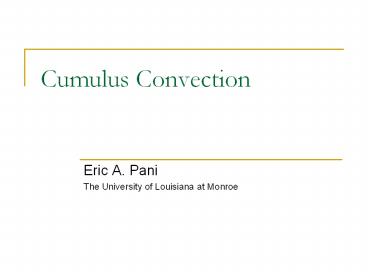Cumulus Convection PowerPoint PPT Presentation
Title: Cumulus Convection
1
Cumulus Convection
- Eric A. Pani
- The University of Louisiana at Monroe
2
Overview
- Have taken simplified view of convection so far
- Only force considered has been buoyancy
- Are there other forces involved? If so, what are
they?
3
Entrainment
4
Mathematical Development
Consider a sample of saturated cloud mass, m,
ascending through a distance dz and experiencing
a pressure change dp. As the sample rises, it
entrains a mass dm of unsaturated environmental
air. Model the rising as a saturated adiabatic
cooling of m, an isobaric cooling of m and
warming of dm during mixing, and the evaporation
of part of the liquid water content of m into dm
to produce a final mixture which is saturated.
We will assume that the cloud is horizontally
uniform in temperature, water vapor, and liquid
water and that there are no sources or sinks of
heat.
5
(No Transcript)
6
(No Transcript)
7
(No Transcript)
8
(No Transcript)
9
Results from
- If entrainment rate ( ) gt 0 and cloud is
buoyant, then cloud cools faster than moist
adiabatic - Example at 700 mb, -1C, and 67 environmental
RH, if cloud is at 0C, then moist adiabatic
lapse rate is 5.8C/km compared to cloud lapse
rate of 6.6C/km if entrainment rate is 0.25/km - Typical entrainment rates are 1-2/km (i.e., cloud
doubles or triples its mass with each km of
ascent)
10
Where does entrained air go?
- Large entrainment rates indicate cloud mass is
increasing quickly - Would expect width of cloud to increase with
height, but observations do not support this - Some air must move downward in downdrafts not
modeled by theory
PowerShow.com is a leading presentation sharing website. It has millions of presentations already uploaded and available with 1,000s more being uploaded by its users every day. Whatever your area of interest, here you’ll be able to find and view presentations you’ll love and possibly download. And, best of all, it is completely free and easy to use.
You might even have a presentation you’d like to share with others. If so, just upload it to PowerShow.com. We’ll convert it to an HTML5 slideshow that includes all the media types you’ve already added: audio, video, music, pictures, animations and transition effects. Then you can share it with your target audience as well as PowerShow.com’s millions of monthly visitors. And, again, it’s all free.
About the Developers
PowerShow.com is brought to you by CrystalGraphics, the award-winning developer and market-leading publisher of rich-media enhancement products for presentations. Our product offerings include millions of PowerPoint templates, diagrams, animated 3D characters and more.

